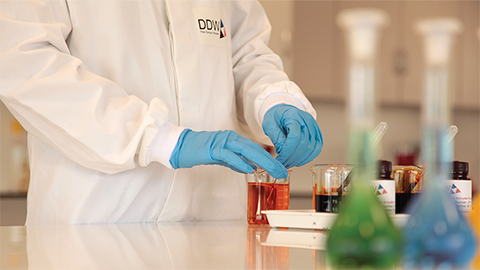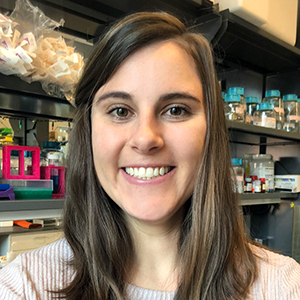Colorful research in the food industry
While the industry careers column usually focuses on the biomedical and biotechnology fields, the food and beverage industry is not to be overlooked. There’s a great amount of chemistry behind the products we consume. Most products have been designed with a specific flavor or color in mind, and these creations need scientists to test, analyze and perfect them before they hit our shelves.

This week I talked with one such scientist — Andrew Kendrick, Ph.D., who works for DDW, The Color House. DDW is a global corporation that develops natural colorings for the food and beverage industry. Kendrick is based in the U.K. In my next column, I will feature a scientist from an office in the U.S.
I first heard about DDW through Gastropod, a food-centric podcast that often includes exciting tidbits about the science behind what we eat. This particular episode (called “Eating the Rainbow” if you’re interested) focused on how food and drink products get to be the color they are and how companies like DDW are working to replace synthetic colorings with natural ones.
The process is incredibly scientific and highlights just one of the many applications for scientists in the food industry. I interviewed Kendrick to get a better understanding of what his job entails, how he got into the industry, and what advice he has for anyone looking to break in.
Getting started in the field
First, a bit of background about Kendrick. He earned an undergraduate degree in biochemistry from Hull University in the U.K. and studied the production of long-chain fatty acids in fungi for his Ph.D. thesis work. He was partially interested in biochemistry because of its focus on microbial systems at his university. The idea that these small creatures could be harnessed to mass-produce material was fascinating to him.
This fascination led to his first roles in the food industry, where he worked to bulk produce citric acid by fermentation and also tried to take the smell and taste out of fish oil. Both the citric acid and modified fish oil were to be used as food ingredients. He then decided to specialize in natural food ingredients and moved into creating natural colors, just as the transition away from artificial colors was starting in the U.K.

He said he got started n the natural color industry by sending many applications and initially taking a role that wasn’t a perfect fit based on his background alone. But, over time, he was able to become involved with more relevant projects. He recommends this approach for others who are trying to join the food industry but don’t have a food science background.
“I started low on the technical ladder,” he said. “But I worked hard, got involved in as many projects I could, and was shortly promoted. Don’t be shy: Ask for promotions as you gain experience.”
Once he was promoted, he was able to really kickstart his career in natural colors.
Developing natural colors at DDW
At DDW, Kendrick is a research and development manager and is responsible for developing new color systems to overcome stability, vibrancy or shade issues. He works with customers to deliver specific colors for their desired applications, oftentimes working to match a certain flavor profile.
While he’s not at the bench anymore, he does direct the lab work for a small team. Their goal is to give customers colors derived from natural sources that match the intensity and stability of artificial colors.
They work to understand the fundamentals of what is happening to their natural dyes under a variety of conditions using instruments that are specifically focused on color and stability measurements (among others). These kind of data are important for customers who want to understand how the color of their product will change after spending time on supermarket shelves.
For example, they may analyze how their color changes across various pH, which is important for the beverage industry because drinks can range from acidic pH (such as soda) to neural pH (such as water). They can also determine how their dyes respond to temperature, heating and cooling cycles, and intensity changes over time.
Once the color has been thoroughly vetted, the customer can scale up its production for use in their products. For Kendrick, the most rewarding part of his job is seeing something in the supermarket that he helped develop the color for.
“My favorite part is seeing something that I helped test on a small lab scale, maybe testing only a couple of milliliters, then scaled up to be mass produced and distributed throughout the U.K.,” he said.
Science background in food technology
If you want to break in to the food industry but don’t have a background in food science, don’t let that hold you back. Kendrick is not a food technologist by training but did join the industry with a solid scientific background in biochemistry and an enthusiasm for all things related to food.
“The benefit of a non-food technologist coming into the food industry is that we probably have a more fundamental understanding of what’s going on at the molecular level,” he said.
He gave an example of the process of making cheese — food technologists know exactly what’s going on, but, as a scientist, you also understand the fundamentals of solubility or how adding an acid can cause proteins to coagulate and change texture; thus, the process may be easier to troubleshoot.
“As for designing a food dye, we scientists have an edge because of our experience with scientific rigor,” he said.
In light of the current COVID-19 pandemic and all of its implications for the workforce, you might be wondering how stable a career in the food industry will be. Kendrick had an answer for that as well.
“I’ve been through a couple of recessions and now a pandemic, and people still need to eat,” he said. “There may be changes and fluctuations, but the core bulk production of foodstuffs is a pretty stable industry.”
Advice for transitioning into the food industry
Kendrick's path shows how you can transition into an industry that doesn’t perfectly fit with your academic background or training experience. He says enthusiasm, good interpersonal skills, proven ability to work hard, and a fundamental scientific understanding can take you a long way when first starting out. Once you get your first job, you can pick up the specialty knowledge from within the company that you join.
If you want to spin your past experience to increase your application's chances (or look for new experiences to help set you up for this career in the future), Kendrick also has some suggestions.
“Try to find any kind of project that demonstrates that you truly understand a food or food product,” he said. “If you go below the surface, that would be appealing to this industry.”
Think about how a food product has been built up, what processes underly its creation, how it could be manufactured or modified to produce more desirable qualities. Projects don’t even have to be directly related to food — Kendrick first started studying long-chain fatty acids in fungi. The scientific and technical skills you learn can be transferred to food applications.
Above all, Kendrick said, approach your work with determination and enthusiasm. It’s OK to start out at the bottom as you learn the specifics of the food field you’re entering.
“The food industry offers such a wide range of options for roles you would never know exist,” he said. “Join a company with your eyes open, and do not be afraid to talk to people and ask them about their jobs, even if it means taking on more work and responsibility early on. It’s worth the effort, and the extra exposure you get will bring the rewards.”
Enjoy reading ASBMB Today?
Become a member to receive the print edition four times a year and the digital edition monthly.
Learn moreFeatured jobs
from the ASBMB career center
Get the latest from ASBMB Today
Enter your email address, and we’ll send you a weekly email with recent articles, interviews and more.
Latest in Careers
Careers highlights or most popular articles

Upcoming opportunities
Calling all biochemistry and molecular biology educators! Share your teaching experiences and insights in ASBMB Today’s essay series. Submit your essay or pitch by Jan. 15, 2026.

Mapping proteins, one side chain at a time
Roland Dunbrack Jr. will receive the ASBMB DeLano Award for Computational Biosciences at the ASBMB Annual Meeting, March 7–10, just outside of Washington, D.C.

Exploring the link between lipids and longevity
Meng Wang will present her work on metabolism and aging at the ASBMB Annual Meeting, March 7-10, just outside of Washington, D.C.

Upcoming opportunities
Calling all biochemistry and molecular biology educators! Share your teaching experiences and insights in ASBMB Today’s essay series. Submit your essay or pitch by Jan. 15, 2026.

Defining a ‘crucial gatekeeper’ of lipid metabolism
George Carman receives the Herbert Tabor Research Award at the ASBMB Annual Meeting, March 7–10, just outside of Washington, D.C.

Building the blueprint to block HIV
Wesley Sundquist will present his work on the HIV capsid and revolutionary drug, Lenacapavir, at the ASBMB Annual Meeting, March 7–10, in Maryland.

